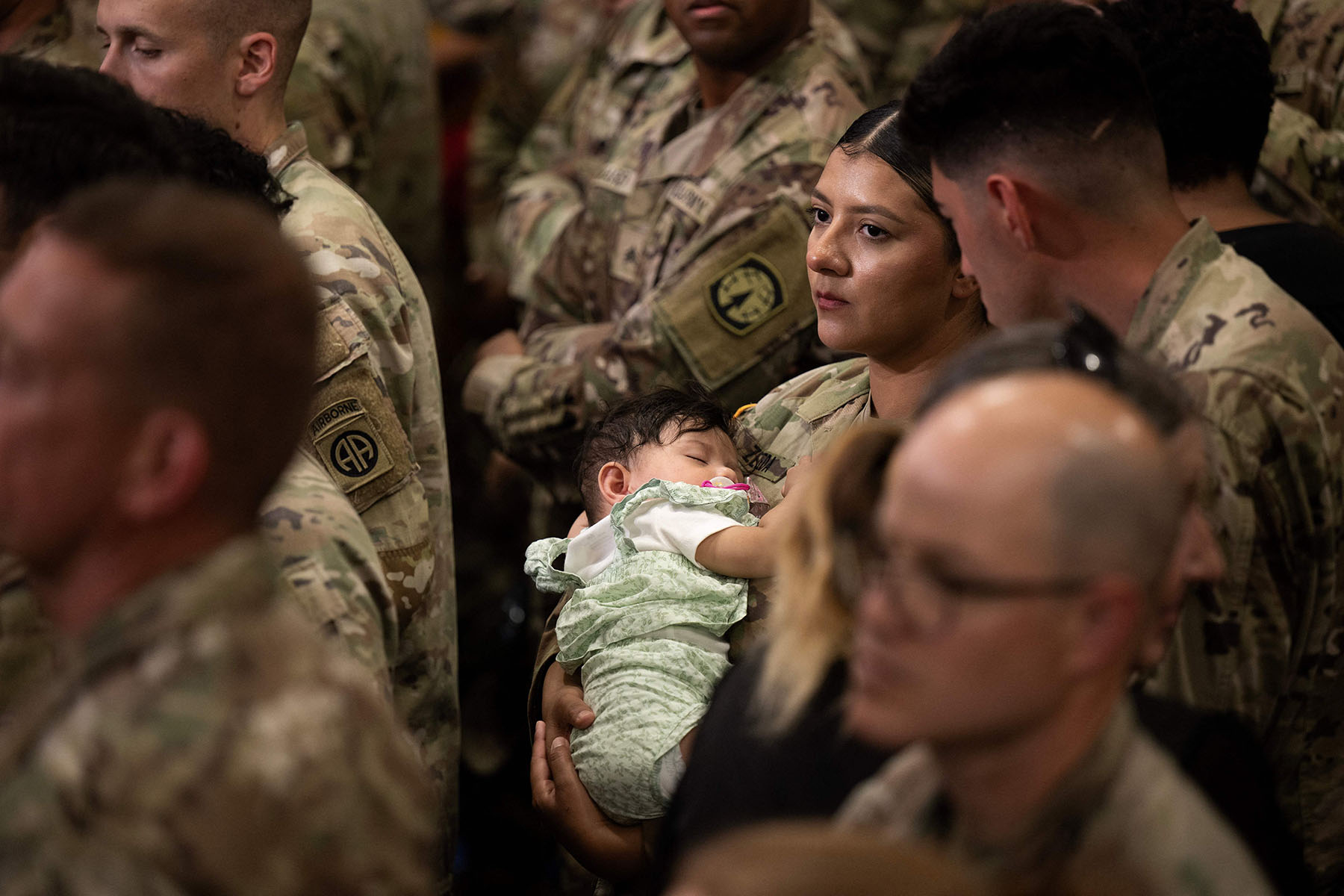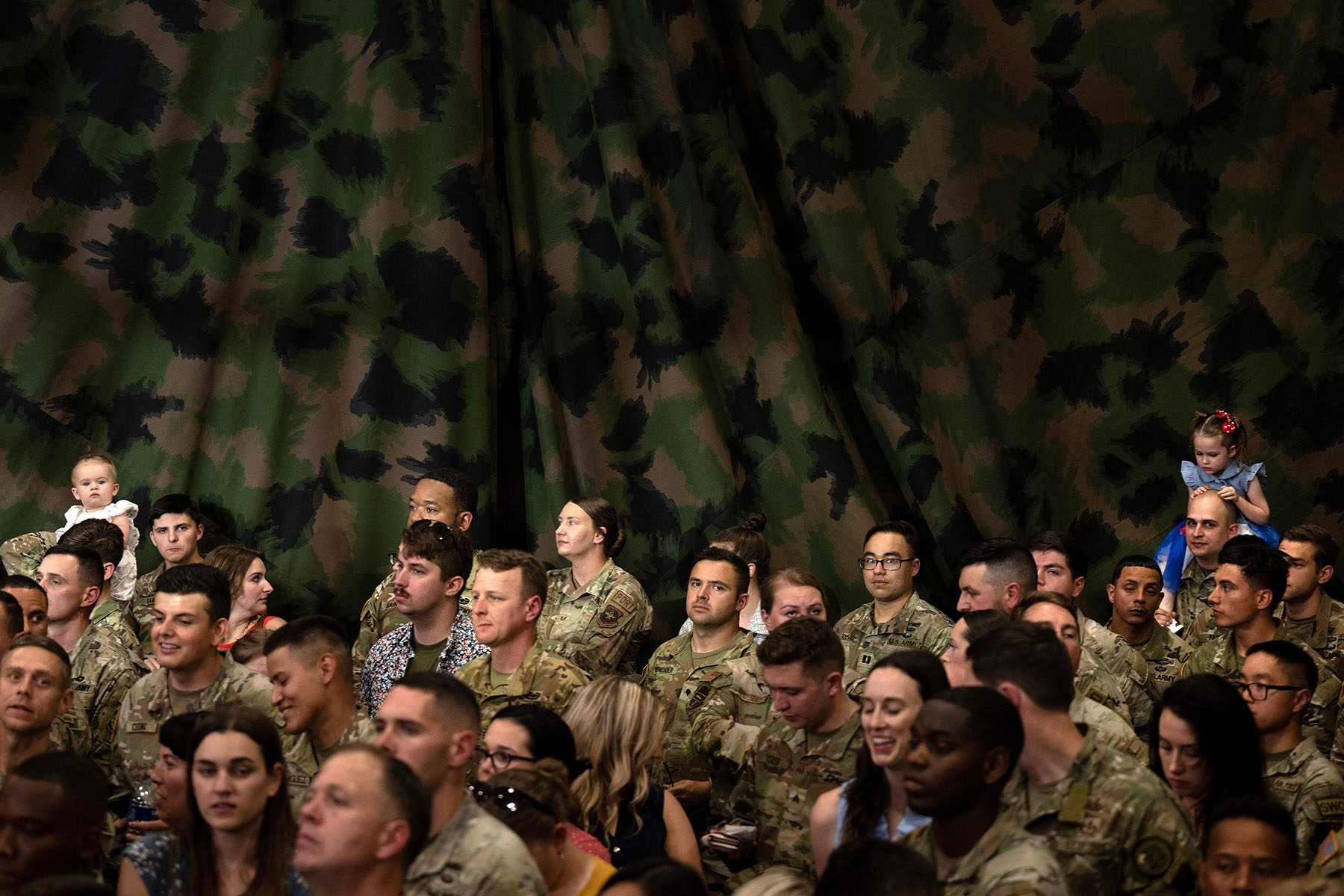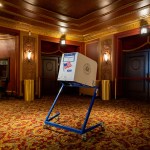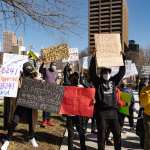It was time to vote in the 2020 election and Megan Paone, a U.S. military spouse, was stationed in Okinawa, Japan. Everything seemed straightforward: Request an absentee ballot, fill it out and send it back. When the ballot arrived, Paone made sure to fill it out and mail it back the next day to ensure it got back to her home state of South Dakota in time.
Some time later when Paone went to her county supervisor’s website to look up her ballot identification number, it said her ballot had been “received but not counted.”
Intrigued, she sent an email to the county supervisor of elections, but did not get a response.
“When I first married my service member, I was like, ‘Oh my God, it’s going to be so easy to vote because we’re military and it should just be an easier process for us,’” Paone said. “But actually, it is not at all. It can be complicated, especially with different deadlines from state to state. It’s kind of like a Whac-A-Mole.”
As a voting bloc, the military community is sizable: There are nearly 1.3 million active-duty troops, and that’s not taking their spouses and any other household adults into account. But the military community votes at much lower rates than their civilian counterparts. In 2022, only 26 percent of active-duty military voted compared to 46.2 percent of the general population — even though about 75 percent are eligible to vote absentee with special protections because of their station location or deployment status. The 19th spoke to several military spouses and election advocates who said the reasoning is layered: Military families move often and have to navigate varying and changing state laws, administrative hurdles and a lack of resources.
Paone, now 46 and living in the Tampa Bay region of Florida, said she’s moved eight times in the last 10 years with her husband, who is an active-duty Army officer. For her, voting was always a priority, so she did the research; figured out where, when and how to register to vote; and obtained a new driver’s license in places that required voters to show proof of identity.
She did this in part because service members are not allowed to vote in person on military installations, embassies or consulates.
“Every post that we have been to offers a lifestyle that people can get used to, including grocery stores, pharmacies, hospitals, clinics, libraries, waterparks — I mean everything that you need to live a good, productive life is available on post,” Paone said. “The only thing you cannot do right now is vote.”
In addition to the logistical barriers that might discourage voter participation, Streyder said there’s also a lack of voting resources and overall motivation.
The majority of military voters vote using absentee ballots and are given special considerations under the Uniformed and Overseas Citizens Absentee Voting Act, which was established in 1986 and updated in 2009. The act requires that states send blank ballots to service members and others overseas at least 45 days before federal elections, offer at least one method of electronic transmission of voting information and blank ballots, and transmit requested ballots automatically within the calendar year.
The Federal Voting Assistance Program administers the federal responsibilities of the bill, which are to provide nonpartisan information about voter registration and the absentee voting process to military and overseas voters, establish volunteer voting assistance officers at each base and remind states of their requirements when interacting with military and overseas voters. However, many in the military community are unaware that these resources even exist.
The Department of Defense did not respond to a request for comment in time for publication.
With these federal protections and programs in place, the number of military voters who report not receiving a ballot in time — or at all — has steadily decreased each year. But there are still more challenges that military voters typically have to face when trying to participate in elections.
For instance, the state legislative landscape shifted following 2020, with states going in two very different directions when it comes to voting, according to Sarah Streyder, the executive director of Secure Families Initiative, a group for military spouses dedicated to mobilizing the military community to vote.
There are states that started to codify things like voting by mail to make it more available on a permanent basis after creating temporary provisions during the COVID-19 pandemic, Streyder said. Then, she said, there are those that have decreased the window of opportunity for people to both register and return their absentee ballots.
“2020 taught us that our voters are like a canary in the coal mine in some ways,” said Streyder, who is married to an active-duty Space Force Guardian. “We are some of the most vulnerable voters to some of these policies. But if we make policies more robust for us, they’re going to benefit more than just us. I also want non-military civilians to be able to vote seamlessly.”
The states that have decreased the time service members have to register and return their ballots are making it even more difficult for military voters to get their ballots counted, Streyder said. In at least 28 states voters will face restrictions that weren’t in place in the last presidential election, according to the Brennan Center for Justice. Ohio and Tennessee, for instance, shortened the window of time that a ballot can arrive after election day and still be counted. Alabama and Idaho passed laws that broadly criminalize certain forms of assistance with absentee voting. An Arizona law shortens the period in which voters can fix issues with signatures on mail ballots. And in West Virginia, county clerks are now required to cancel the registration of voters who get out-of-state driver’s licenses.

“I think a common myth that I’ve encountered amongst civilian voters and lawmakers is that the military votes at high rates because of a sense of civic service,” Streyder said. “But I’ve found this argument for voting flounders with the actively serving military audience — whether it’s the service member or their loved one — because our entire lives are already fully committed to this concept of service. The idea that there’s an additional obligation on top of all of this can sometimes be really hard to agree to.”
For starters, voter registration is one of just many things a family might have to consider after a move. “I put effort into voting, but I am probably an anomaly,” Paone said. “When people move for the military, registering for an election is not top of mind for individuals or families. It’s ‘Where am I going to live? What school are my kids going to? I need to find primary care.’”
Other members of the military community sometimes feel insufficient, Streyder said. They don’t feel like they’re up to speed enough to weigh in on local issues or they don’t feel like they should have a say in a community when they’ll only be stationed there for a few years at most.
To motivate all of these types of voters, Streyder said she highlights why voting is in their best interest and how it’s one of the rare opportunities in the military to have a say in who their future boss or commander in chief will be.
“I try to encourage folks to remember that you’ve lived all around the world, which has given you a really broad perspective about what’s possible, what forms of government can look like, what quality of life can look like that may be different from a more limited vantage point. That is a value add and a gift that you get to give your civilian neighbors back home when you vote,” she said.
When military voters do cast their ballots, most opt for absentee voting. But a small percentage register to vote wherever they’re living, despite the increasing complexity that typically comes with that.
For example, Ellie Walker, a military spouse currently based in Georgia, said having children is a big motivator in her decision to re-register and vote locally wherever they move because she wants to make sure she has a say in issues that directly impact her family.
“It is up to me to do my due diligence wherever I’m being stationed,” said Walker, who has moved five times in the last 12 years. “If I want to vote there, I need to know what’s happening in the communities we live in. It has fallen on me. We are a family of color — so what our community looks like and the leaders that are there impact our experience while we’re stationed there. So if I don’t vote, I’m choosing to be silent.”
The active-duty military population is not a monolith. It is racially diverse — representative of the country as a whole — and young, with the majority being younger than 30. More than 90 percent of military spouses are women.
Walker said when her husband is out at sea, it often falls on her as the military spouse to handle household responsibilities, including moving logistics, budgets, schooling, health care and — in her case — voting registration. She said participating in elections is an integral way to shift military culture.
“There’s a stance [military spouses] can take because we don’t wear the uniform,” Walker said. “Whereas there’s things that you still can’t speak out on when you’re on active duty. So it’s up to military spouses or families to speak up on these issues, and I’ll be happy to step into that role.”
When it comes to getting more people in her community to vote, Walker said it’s important to let people know that there are resources available, whether on the Federal Voting Assistance Program website or through advocacy groups, like Secure Families Initiative, and to keep reiterating the importance of voting, even amid the moving and the deployments.
“Whether we’re in a presidential election or not, you want to have an impact in your community because your community impacts you,” Walker said. “It’s a mutual relationship.”
Walker said her husband, a Coast Guard recruiter, put cards on his desk with QR codes to help people register to vote. When he talks to potential recruits, he ends the conversation by asking if they know if they’re registered to vote and offers the card with more resources.
“We started getting our recruiters and frontline members talking to new people joining — that’s also an additional grassroots effort to increase the turnout,” Walker said. “It takes everybody.”







